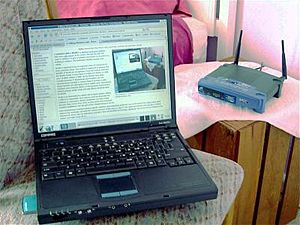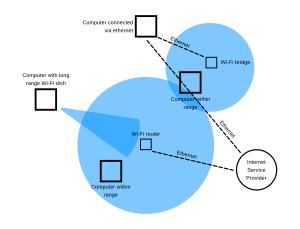Wireless LAN facts for kids
Imagine connecting your computer or phone to the internet without any wires! That's what a Wireless LAN (WLAN) or Wireless Local Area Network does. It's a type of computer network that uses radio waves instead of cables. This lets your devices talk to each other and the internet wirelessly. Most WLANs use a special set of rules called IEEE 802.11, which you might know as Wi-Fi.
Contents
Why Wireless LANs Are Great
Wireless LANs offer many cool benefits:
- Freedom to Move: You can use your devices anywhere within the network's range. No more being stuck next to a wall outlet!
- Hotspots Everywhere: Many public places, like cafes, airports, and even trains, have Wi-Fi hotspots. This means you can get online even when you're away from home or school.
- Easy Setup: Setting up a wireless network is often simpler than a wired one. You usually just need one device called a wireless access point or wireless router. This device can connect many computers at once.
- Less Clutter: Since there are no cables, your space looks much tidier!
Things to Consider with Wireless LANs
While wireless networks are super handy, they do have a few things to keep in mind:
- Security: Because radio waves travel through the air, it's easier for others to try and listen in. So, it's very important to encrypt (scramble) your information to keep it safe.
- Signal Quality: Wireless signals can sometimes be "noisier" than wired ones. This means the network has to work harder to fix any errors in the data.
- Limited Range: A typical Wi-Fi signal can only reach a certain distance, usually 30 to 100 meters indoors. If you need to cover a larger area, you'll need more access points.
- Interference: Other electronic devices, like microwaves or cordless phones, can sometimes interfere with Wi-Fi signals. This can make your connection slower or less reliable.
- Speed: Wireless networks are generally slower than wired ones. However, for most home users, the speed of your internet connection (like ADSL) is usually the main limit, not the Wi-Fi itself.
How Wireless LANs Work
Most modern Wireless LANs use a clever technology called Orthogonal Frequency Division Multiplexing (OFDM). This sounds complicated, but it just means the network uses several different radio frequencies at the same time.
These different frequencies are carefully designed so they don't interfere with each other, even when they are close. This helps the network send more data reliably. Indoors, Wi-Fi can usually cover 30 to 100 meters. Outdoors, if there are no big obstacles, the range can be about 100 to 300 meters.
Images for kids
-
This notebook computer is connected to a wireless access point using a PC Card wireless card.
See also
 In Spanish: Red de área local inalámbrica para niños
In Spanish: Red de área local inalámbrica para niños






